Electric Pumps for Kiteboarding: A Complete Guide
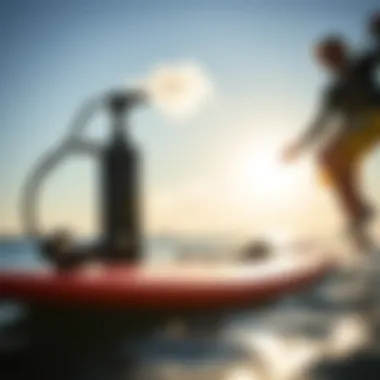
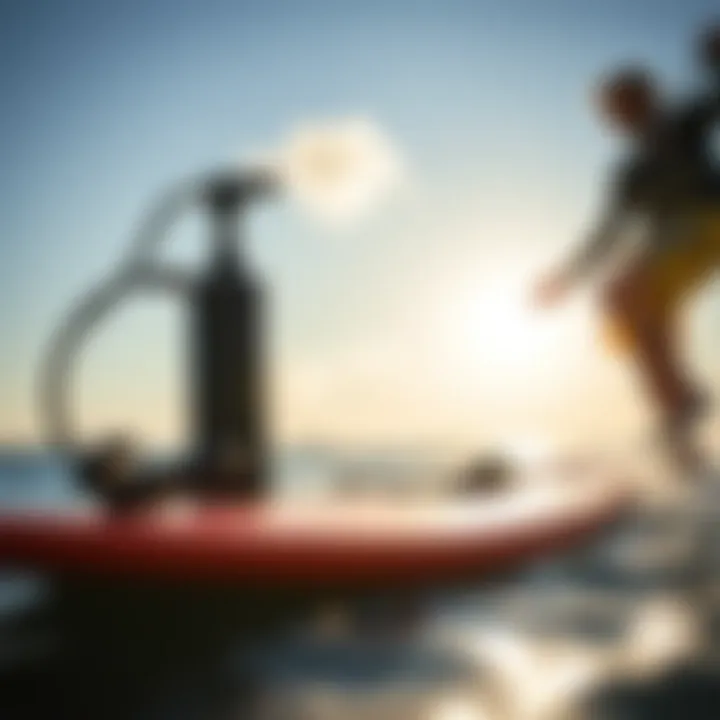
Intro
Electric pumps have become a game changer in kiteboarding, offering kiteboarders a way to optimize their time on the water. The simple act of inflating a kite once required significant human effort, often leading to exhaustion before even hitting the waves. Now, with electric pumps, that tedious task is fast and effortless, allowing enthusiasts to fully invest their energies into riding.
Understanding how these devices integrate into the kiteboarding culture is crucial. They offer convenience but also bring a range of features and options that may overwhelm newcomers. This guide will unpack the essential elements surrounding electric pumps specifically tailored for kiteboarding, aiming to enlighten both beginners and seasoned riders on the nuances of these tools.
From comparing the benefits of electric pumps to their manual counterparts to delving into the features you should prioritize when selecting one, the following sections will provide a thorough understanding that can elevate your kiteboarding journey.
As we dive deeper, it’s notable to mention the impact that an efficient electric pump can have not just on convenience but also on safety and performance. After all, kiteboarding is as much about technique as it is about being well-equipped.
Beyond just the inflating aspect, understanding how these devices work and their maintenance will further enhance your experience on the water.
So, strap in, let’s explore the gear insights, techniques, and tips that will ensure your kiteboarding adventures are as delightful as they are thrilling.
Prolusion to Electric Pumps
In the world of kiteboarding, having the right gear can mean the difference between a smooth ride and a day of frustration. This is where electric pumps come into play, revolutionizing the pre-flight phase of this thrilling sport. While traditional manual pumps have served their purpose over the years, electric pumps bring efficiency and convenience to the game. The evolution of pump technology aligns perfectly with the increasing demands of kiteboarders who seek to maximize their time on the water. Understanding electric pumps aids enthusiasts in making informed decisions, ensuring they choose the right model that suits their needs.
Defining Electric Pumps
Electric pumps are devices powered by electricity to inflate kites efficiently and quickly, eliminating the physical strain associated with the manual pumping process. Unlike their manual counterparts that require significant effort and time to inflate, electric pumps can fill a kite in mere moments. They typically operate by drawing air into the pump and forcing it into the kite, often equipped with pressure gauges that help reach the desired inflation levels.
These pumps are especially valuable for kiteboarders who may struggle with strenuous efforts before hitting the water. For instance, consider someone preparing for a thrilling day at the beach. After lugging gear to the sand, they’d much prefer an electric pump that gets their kite ready without breaking a sweat. Additionally, many electric pump models allow for adjustable pressure settings, ensuring that the kite can be inflated to specifications optimal for performance.
Evolution of Pump Technology
The genesis of pump technology stretches back to basic manual devices, often requiring considerable physical effort and time. However, as the sport of kiteboarding grew in popularity, so did the innovation surrounding equipment. In the early 2000s, advancements in battery technology allowed manufacturers to create portable electric pumps that catered to kiteboarders’ needs. This allowed riders to transition from a labor-intensive task into one that required a simple push of a button.
Today's electric pumps often include features such as lightweight designs, rechargeable lithium-ion batteries, and adjustable nozzles compatible with various kite sizes. Furthermore, the integration of digital technology has provided riders with real-time pressure monitoring, allowing for precise inflation levels critical to kite performance. It's fascinating to observe how these changes reflect broader technological trends, enabling a new generation of kiteboarders to enjoy the sport with enhanced ease and efficiency.
"The evolution of pump technology mirrors the dynamic changes in kiteboarding itself, emphasizing convenience and performance."
Advantages of Electric Pumps for Kiteboarding
Understanding the advantages of electric pumps specific to kiteboarding is a game changer for enthusiasts at all levels. While traditionally, manual pumps served kiteboarders for years, the growing popularity of electric pumps has brought forth a myriad of benefits that cannot be dismissed. From ease of use to enhanced performance, electric pumps have transformed the way riders prepare for their time on the water. In this section, we will delve into key elements that make electric pumps a must-have in the kiteboarding toolkit.
Efficiency in Inflation
Inflating a kite is often a strenuous task, especially when it's early in the morning and energy levels are not at their peak. Electric pumps take away that burden, allowing riders to spend more time focusing on what truly matters – riding. Typically, an electric pump can inflate a kite in a fraction of the time it takes with a manual pump. For instance, a typical manual pump might require anywhere from 5 to 10 minutes to inflate, whereas electric variants can do the job in about 2 to 3 minutes. This efficiency means less struggle and more exhilaration.
Additionally, the push-button ease of inflation lets kiteboarders start their sessions much more swiftly. Once plugged in, all you need to do is set the desired pressure level and let the pump do its thing. Many models even come equipped with automatic shut-off features to prevent over-inflation, ensuring that the kite is in optimal condition without the need for constant checking.
Consistent Pressure Maintenance
One of the commonly overlooked aspects of kite performance is the pressure within the kite itself. Electric pumps excel not only in initial inflation but also in maintaining consistent pressure throughout your time on the water. Unlike manual pumps, where users might risk deflation during setup or even after hitting the waves, electric pumps provide uniform and reliable pressure. This is essential in kiteboarding, as even a slight drop in pressure can affect the kite's responsiveness.
By utilizing pressure gauges, some electric pumps can detect whether the desired PSI is maintained or needs adjusting, offering a level of precision that manual pumps simply can't match. This consistency ensures that the kite behaves as expected during maneuvers, giving riders the confidence to push their limits while they’re out making waves.
Reduced Physical Strain
The physical demands of kiteboarding can wear you out before you even hit the water. Electric pumps eliminate much of this strain, allowing riders to conserve energy for what really counts—actually riding. The agility needed to maneuver a manual pump can be tough on the back, shoulders, and arms. In contrast, electric pumps provide a hands-free solution, allowing individuals to avoid unnecessary fatigue before their session.
Moreover, for older riders or those with physical limitations, an electric pump can be a game changer, offering access to the sport without the daunting task of manual inflation. In this way, electric pumps not only enhance performance but also make kiteboarding more inclusive for a diverse range of participants.
"Electric pumps married efficiency with ease, reshaping the kiteboarding experience from exhausting to exhilarating."
Overall, the advantages of using electric pumps in kiteboarding are evident in their efficiency, pressure maintenance capabilities, and the reduction of physical strain. Transitioning to electric pumps is not just a convenience, it's an investment in a more enjoyable kiteboarding experience. With the right pump, you can focus more on riding and less on the preparation, which is what every kiteboarder truly wants.
Comparative Analysis: Electric vs. Manual Pumps
In the world of kiteboarding, the choice between electric and manual pumps is not just a matter of personal preference; it can affect your time on the water and overall experience. Understanding the nuances between these two styles of inflatable tools allows kiteboarders to make informed decisions that could enhance their sessions or even transform their entire playing field.
Time Efficiency
One of the first things that come to mind when comparing electric and manual pumps is time efficiency. In the hustle and bustle of gearing up for a session, every minute counts. An electric pump can inflate your kite in not just a few minutes but could easily cut that time down to a less than the time it takes to brew a cup of coffee.
Manual pumps, on the other hand, require good old-fashioned elbow grease. While they can get the job done—with some serious heart and muscle—it’s often the slow road to inflation. For those in a hurry to get out on the water, the difference can be stark.
"Time is money, especially when the wind is just right!"
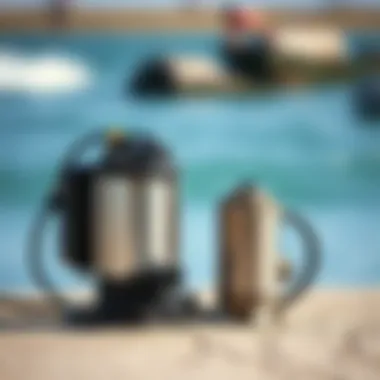
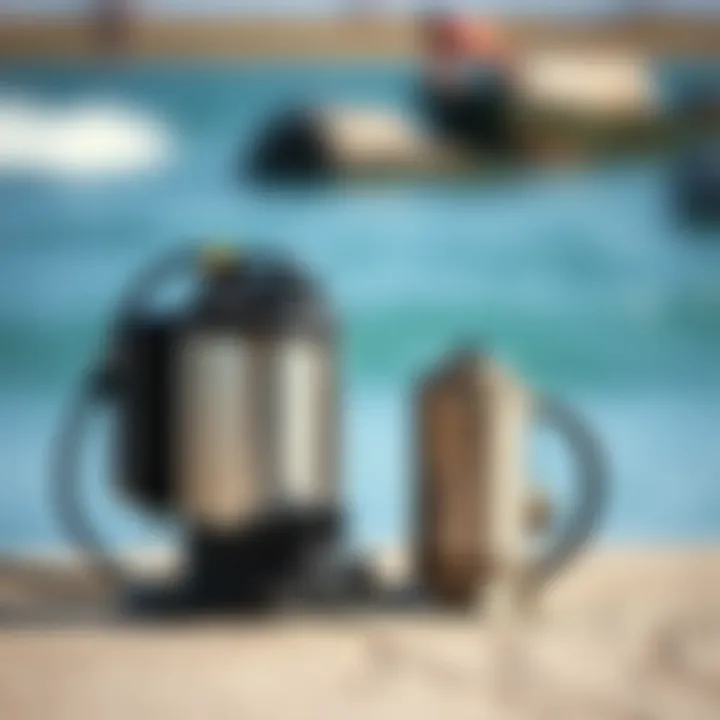
Not only does an electric pump save time, but it also enables you to pump multiple kites in succession without wearing yourself out. For group outings or when you’re sharing the fun, that’s a game-changer.
Inflation Pressure and Volume
Inflation pressure is another crucial aspect to consider. Electric pumps are often designed with precise pressure settings, ensuring that the kite reaches optimal inflation without guesswork. This consistent pressure leads to improved performance while riding, as a fully inflated kite behaves more predictably.
When you use a manual pump, it can be challenging to maintain a steady pressure. You might pump away zealously, thinking you’ve hit the sweet spot, only to find you’ve either over-inflated—causing a risky situation—or under-inflated, which could lead to a less-than-ideal ride.
Therefore, for kiteboarders keen on maximizing their performance, investing in an electric pump that can deliver consistent pressure and volume might outweigh the nostalgia of pumping by hand.
Long-Term Cost Considerations
From a financial perspective, initial investment in an electric pump may seem steep compared to manual options, where the price tags are lighter. However, potential kiteboarders should consider long-term costs as part of their analysis. Electric pumps can save valuable energy and may prevent injuries resulting from repetitive manual pumping.
In the short run, a manual pump may seem cheaper and serve many a kiteboarder well. Yet, if you’re regularly hitting the water and finding yourself battling with cumbersome strenuous pumping routines, the toll on your body could lead to expenses in physical therapy and recovery that far outweigh the cost of an electric pump.
Additionally, electric pumps typically come with warranties and longer product life, which means your investment might last longer and serve you better over time.
In summary, understanding the comparative advantages enables kiteboarders to weigh their options wisely, from efficiency to performance and costs in the long haul. This informed choice leads not just to a better trip at sea, but also a healthier and more enjoyable kiteboarding experience.
Key Features to Look for in an Electric Pump
When choosing an electric pump for kiteboarding, it’s essential to be aware of the various attributes that will influence its performance and efficiency. Different aspects, such as the power source, inflation speed, and safety features can make a world of difference, especially when you’re out on the water, ready for a thrilling session.
It's not just about getting air into your kite quickly; these features combined ensure that you have a seamless and enjoyable experience while minimizing potential setbacks. Understanding what to search for in an electric pump will arm you with knowledge to make an informed decision required for your specific needs, whether you're a seasoned pro or just starting your kiteboarding journey.
Power Source Options
One of the foremost considerations when selecting an electric pump is its power source. Power sources can vary, ranging from battery-operated models to those intended for use with standard electrical outlets.
- Battery-Operated Pumps: These are particularly handy for beach goers as they provide portability without the need for an outlet. However, battery life can be an issue if you’re planning to inflate multiple kites or spend all day out. A model with a long-lasting battery or the option to carry spare batteries will save you from unexpected hiccups.
- Electric Outlet Pumps: These generally offer faster inflation but can limit your mobility. If you’re sticking close to your vehicle or at a designated launch area with electrical access, this may be a great choice. Just ensure you have the adequate extension cords if needed.
Ultimately, the decision boils down to your kiteboarding habits and the environments in which you practice.
Inflation Speed
Inflation speed is a game changer when you consider how quickly you can get out on the water. A pump that can fill your kite in under a couple of minutes allows you to maximize your session time instead of wasting it on manual inflation. The efficiency of the pump largely depends on the motor and its design.
When assessing the inflation speed, look for details such as:
- Volume per minute: This will give you a sense of how quickly the pump can fill your kite. A good pump can deliver anywhere from 5 to 10 liters per minute.
- Dual-stage operation: Some advanced pumps offer a dual-stage process—first inflating rapidly and then fine-tuning the pressure to the exact level needed. This feature could be pivotal for serious kiteboarders looking for optimal performance.
Built-in Safety Features
Safety should never be an afterthought, especially when dealing with electrical equipment outdoors. Pumps equipped with practical safety features can help prevent accidents that can ruin a day on the water—or worse.
Consider the following safety aspects:
- Automatic Shut-off: This feature stops the pump when the desired pressure is reached. This agility in stopping can prevent over-inflation, which damages your kite or leads to risks on the water.
- Ventilation Systems: A well-designed pump will often have vents for heat dissipation. Continuous operation can lead to overheating, and features that allow for cooling will prolong the life of the motor.
- Waterproofing: Since spills happen, having a pump that provides a degree of weather resistance or waterproofing can save you from potential failures during those unexpected showers.
In summary, evaluating these essential features when choosing an electric pump allows you to invest your money wisely. The combination of the power source, inflation speed, and built-in safety mechanisms will set you on a path towards smoother and more enjoyable kiteboarding experiences.
"Buying the right pump is like getting into the right gear—it's essential for your kiteboarding success.
Learn to choose wisely, and you won’t regret it."
Ultimately, making an informed choice will have long-lasting implications on your kiteboarding adventures.
Maintenance and Care for Electric Pumps
Taking proper care of electric pumps is not just a good practice, it’s essential for prolonging the life and ensuring the operation of your equipment. This is particularly true for kiteboarding, where the performance and reliability of your pump can make or break your adventure on the water. The following points delve into the significance of maintaining electric pumps, the advantages of regular upkeep, and certain considerations to keep in mind.
Cleaning Practices
Regular cleaning is the cornerstone of pump maintenance. Salt water, sand, and even dirt from the beach can accumulate in various parts, affecting efficiency over time. Here’s how to ensure your pump stays in tip-top shape:
- Rinse After Use: Each time you return from a session, quickly rinse the pump with fresh water. This simple step helps to wash away any salt or grit that could cause damage.
- Use a Soft Cloth: Wipe down the exterior, paying attention to the air filter if your pump has one. Avoid anything abrasive that could scratch surfaces or disturb seals.
- Check for Blockages: After every few uses, inspect the intake and discharge valves for any blockages. Clear them gently to maintain optimal airflow.
"Cleaning and care not only extends the life of your pump but enhances overall performance, ensuring you get the most from your setup."
Inspecting Electrical Components


The heart of an electric pump lies within its electrical components. Regular inspections can prevent bigger issues down the line. Here are some tips:
- Check Wiring and Connections: Over time, wires can fray or connections may loosen. A quick visual check can save you from a failure out on the water.
- Look for Rust or Corrosion: If you notice any signs of rust, especially in saltwater conditions, take remedial action quickly. Applying an anti-corrosive spray can help protect the connections.
- Test Battery Life: If your pump is battery-operated, periodically check battery health. Replace batteries as needed to ensure reliability during kiteboarding trips.
Storage Recommendations
How you store your electric pump can heavily influence its lifespan and performance. Here’s what to keep in mind:
- Climate Control: Avoid storing your pump in extreme temperatures. High heat can affect battery performance while extreme cold can make seals brittle.
- Protect from Pest Damage: Keep it in a place where pests can’t access it. Squirrels or other critters may find the wires inviting to chew on.
- Organize Cables Properly: When winding cables for storage, avoid tight bends which can damage insulation. Instead, use a gentle loop to prevent kinks.
Taking these maintenance steps not only keeps your equipment functioning well but contributes significantly to the overall experience of kiteboarding. Whether you’re a beginner or a seasoned pro, understanding how to maintain your electric pump is invaluable insight that leads to better outings on the water.
Popular Electric Pump Models Reviewed
Understanding the various electric pump models available on the market is crucial for kiteboarding enthusiasts. Each model brings its own unique features, benefits, and drawbacks, which can significantly influence your kiteboarding experience. Whether you’re a beginner or have been riding the waves for years, knowing what each pump offers can make or break your time on the water. Given the growing market, let’s take a closer look at a few standout models that have made a name for themselves in the kitboarding community.
Model A Overview
Model A, often referred to as the AirRush Aero Pump, is particularly notable for its rapid inflation capabilities. Designed with kiteboarders in mind, this model boasts a lightweight, compact frame that makes it easy to carry around.
Key features include:
- Inflation Speed: The AirRush Aero Pump can inflate a standard kite in less than five minutes, which is a game changer for those looking to get on the water quickly.
- User-friendly Interface: It comes with an easy-to-read pressure gauge, allowing users to monitor inflation levels without any guesswork.
- Wireless Operation: This model offers a battery that supports up to two sessions, meaning you won’t need to worry about plugging it in between uses.
The overall design of Model A also includes weather-resistant components, making it a solid choice for diverse outdoor conditions. Many users have praised it for its efficient operation and reliability.
Model B Features
Next up is the Sevylor Quick Pump, known for its versatility and performance. What sets Model B apart from others is its dual-purpose function, serving both as an electric pump and a manual backup, should the need arise.
Here are some standout features of the Sevylor Quick Pump:
- Adaptable Nozzle System: The ability to switch between different nozzle sizes is crucial, especially for users who own multiple kites.
- Built-in Battery: Not only does it work plugged in, but it can operate wirelessly, giving kiteboarders more freedom at the beach.
- Stability: The pump is designed to remain stable even under heavy conditions, ensuring that your focus remains on inflating your gear rather than juggling a flopping pump.
Considering these features, the Sevylor Quick Pump proves to be a reliable partner, particularly for those who often travel or need adaptability in their pumping solutions.
Model C: Pros and Cons
Lastly, review the Bravo BP12. This unit is marketed for its great balance of power and portability, but like any equipment, it has its ups and downs.
Pros:
- High Pressure: Capable of reaching up to 15 PSI, a key factor for serious kiteboarders aiming for optimal performance.
- Affordability: It comes at a price point that appeals to enthusiasts without breaking the bank.
- Durability: Users have reported that it withstands frequent use and exposure to different environmental factors quite well.
Cons:
- Loud Operation: One of the drawbacks mentioned by users is the noise level during inflation, which could be bothersome in quiet beach settings.
- No Integrated Battery: Unlike some other models, it requires a power outlet for operation, which could be limiting for those in remote locations.
With a solid reputation among intermediate to advanced kiteboarders, the Bravo BP12 serves its purpose well, though potential buyers should weigh these factors carefully before making a decision.
"Choosing the right electric pump can save you time and enhance your overall kiteboarding experience greatly. Each model has its strong suits, tailoring to diverse preferences and needs."
By carefully considering these models, kiteboarders can ensure they make an informed decision that complements their style on the water.
Electrical Considerations in Outdoor Environments
Electric pumps have revolutionized the kiteboarding experience, making inflating kites less of a chore and more of a straightforward process. However, when using these pumps outdoors, kiteboarders must consider specific electrical factors to ensure both performance and safety. Understanding various aspects of electrical usage in outdoor settings is vital for making the most out of electric pumps while avoiding potential mishaps. Below, we delve into significant elements like power supply options and weather resistance features.
Power Supply Options
The first hurdle for kiteboarders relying on electric pumps is ensuring a consistent and reliable power supply. This consideration is essential not only for convenience but also for ensuring the pump can perform its task efficiently. There are a few different options that riders might consider:
- Battery-Powered Pumps: These have gained popularity due to their portability. Lithium-ion batteries, which are lightweight and long-lasting, tend to be the go-to choice. However, users should keep in mind the battery's charge level before heading out to the beach to avoid unexpected interruptions.
- AC Power Sources: When near outlets, AC-powered pumps can be a viable choice. They deliver consistent power for extensive use but can be limiting due to dependency on nearby power sources.
- Solar Options: For the eco-conscious or those who often find themselves in remote locations, solar-powered pumps are emerging. They harness sunlight to recharge batteries but may not be the most reliable without ample sun exposure.
When selecting power supply options, consider your specific kiteboarding habits and where you typically ride. It’s crucial to match your power needs with the available options for efficient and peak performance.
Weather Resistance Features
Outdoor environments can be unpredictable at times. Therefore, when investing in an electric pump, it’s important to assess its weather resistance features. A sturdy pump can make all the difference after a sudden downpour or during gusty winds. Here are a few critical features to look out for:

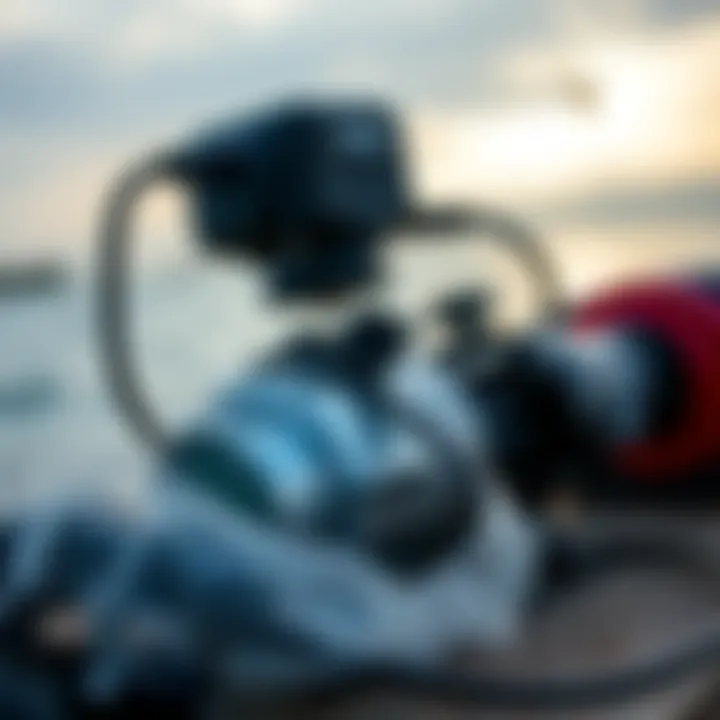
- Waterproof Ratings: Pumps with higher IP ratings tend to be more resistant to water ingress. An IP67 rating or above is advisable for outdoor use, as it signifies protection against immersion in water, which can happen inadvertently at the beach.
- Durability Against Impact: Look for materials like reinforced plastics or high-grade aluminum that withstand rough handling. Kiteboarding involves more than just inflating a kite; equipment can get tossed around, so rugged construction matters.
- Corrosion Resistance: Given the marine environment, check for corrosion-resistant components. Saltwater can degrade electronic devices over time, so materials treated against corrosion ensure longer-lasting functionality.
"Choose a pump that stands the test of nature. It’s not merely about inflation; it’s about reliability in the great outdoors."
Embracing the challenges of outdoor environments means selecting electric pumps that can handle different weather conditions while still delivering consistent performance. By paying attention to your pump’s power supply and weather resistance, you can elevate your kiteboarding experience rather than hinder it through neglect.
For more insight on these elements, you may visit Wikipedia's Electrical Engineering section or engage with fellow enthusiasts on Reddit.
The Environmental Impact of Electric Pumps
Electric pumps are becoming increasingly popular in the kiteboarding community, making it essential to examine their environmental footprint. Understanding the impact of these devices can help kiteboarders make informed choices not only about performance but also about sustainability. The key to balancing a thrilling kiteboarding experience with environmental consciousness lies in grasping how electric pumps can be both efficient and eco-friendly.
Comparative Energy Use
When evaluating the environmental effect of electric pumps, a primary focus falls on their energy consumption. Generally, electric pumps require less energy to operate compared to traditional gas-powered pumps. In many cases, an electric pump can inflate a kite in a fraction of the time it takes a manual pump, ultimately leading to less total energy consumed in the process.
Consider this: a typical manual pump might require significant physical effort from the user to achieve proper inflation, expending more energy on the user's part as well. Transitioning to an electric pump not only reduces this labor but also optimizes the energy used in the inflation process, creating a win-win situation for enthusiasts and the environment alike.
Furthermore, it’s important to note that some electric pumps are designed with energy-efficient technology, including smart sensors that optimize energy use. This means they only draw power when necessary, significantly cutting down on overall electricity consumption. This alignment with energy efficiency is especially pertinent for eco-conscious kiteboarders.
Sustainable Practices in Pump Manufacturing
Sustainability in the manufacturing of electric pumps stands as another vital component of their environmental impact. As kiteboarding gears up for a greener future, manufacturers are increasingly looking into sustainable materials and practices. Many brands now use recyclable plastics in their pump designs, reducing waste and ensuring that parts can be repurposed at the end of the product's life cycle.
Moreover, some companies are implementing lean manufacturing principles to minimize the ecological footprint of their products. This includes reducing waste during production and ensuring the manufacturing process is free from toxic substances that can harm the environment. Consumers who choose electric pumps made with sustainable practices contribute to a market trend that prioritizes environmental care.
"Sustainable practices in pump manufacturing not only benefit the planet but also inspire confidence in users that their choices lead to positive environmental changes."
Finally, as a kiteboarder, you might want to consider purchasing from brands that establish transparent supply chains. Knowing where and how your products are made can make a significant difference and promote responsible consumption.
User Experiences and Testimonials
User insights are invaluable, especially when it comes to gear that enhances a kiteboarder's ride. With electric pumps becoming a staple in the kiteboarding community, gathering user experiences sheds light on how these tools perform in real-life scenarios, guiding both novice and seasoned kiteboarders in their choices. Testimonials help to highlight not just the technical details of a pump, but also its role in making the overall kiteboarding experience smoother, more efficient, and ultimately more enjoyable.
Beginner Insights
For many new to the sport, the world of kiteboarding can be daunting. The learning curve is steep, and equipment choices play a significant role in shaping that experience. Electric pumps offer a way to simplify the often strenuous task of inflating kites.
- Streamlined Process: Beginners often express relief at how an electric pump eliminates the hassle of manual inflation. One such kiteboarder shared:
- Less Physical Strain: The physical demands of kiteboarding are already significant, and for beginners, managing fatigue during the setup process can be tricky. Electric pumps allow newcomers to conserve their energy for riding instead of exhausting themselves before they even hit the water.
- Quick Learning Curve: New kiteboarders can quickly become accustomed to the operation of electric pumps, allowing them to focus on getting to the thrill of boarding rather than fussing over equipment. A simple press of a button gives them confidence, as they engage with the kiteboarding community sooner rather than grappling with equipment challenges.
"With my first session, I struggled with the manual pump. Switching to an electric pump cut my setup time in half."
Advanced Practitioners’ Opinions
For seasoned kiteboarders, the choice of an electric pump is often driven by succinct performance metrics and nuanced experiences. Advanced practitioners have distinct preferences when it comes to the features of electric pumps that match their high-stakes riding sessions.
- Power and Performance: Many experienced riders praise electric pumps for their ability to achieve consistent pressure and volume quickly. This reliability underpins their performance in various wind conditions. One expert remarked:
- Custom Settings: Additionally, advanced users appreciate pumps that allow customization of inflation settings. This feature is essential for fine-tuning kite performance tailored to specific conditions. They often look for models that can inflate their kites with precise pressure gauges, enabling a well-tuned riding experience.
- Durability and Portability: Lots of seasoned kiteboarders evaluate the build quality and portability of their pumps, insisting that a more robust unit can withstand the rigors of travel and use. They seek testimonials from fellow practitioners about how well a pump holds up under repeated use in challenging environments.
"Giving me the right inflation pressure consistently means I can focus on stringing together complex maneuvers without worrying about gear malfunctions."
User experiences and testimonials paint a clearer picture of what to expect from electric pumps in kiteboarding settings. Through shared insights, both novice and advanced kiteboarders can find an electric pump that complements their style, ensuring that they spend more time riding and less time wrangling with equipment.
Culmination: The Future of Electric Pumps in Kiteboarding
The discussion around electric pumps in kiteboarding isn’t just a passing trend; it marks a pivotal moment in how kiteboarding enthusiasts engage with their sport. As technology progresses, the role of electric pumps becomes increasingly significant in enhancing both performance and convenience on the water. Understanding this transition allows kiteboarders to appreciate the value electric pumps bring, from reducing physical exhaustion to ensuring quicker setups.
Anticipated Technological Advancements
Looking ahead, the technological landscape of electric pumps is ripe for change. Manufacturers are keenly aware of the demands of kiteboarding communities and are investing in innovations that prioritize both functionality and efficiency. Future advancements could include:
- Smart Pressure Monitoring: Imagine a pump that can adjust its inflation output based on real-time pressure readings, adapting to different kite types and sizes.
- Battery Life Enhancements: As battery technology improves, we could see pumps operating on longer battery life, extending the time spent on the water without worrying about power supply.
- Lightweight Materials: The trend towards using lighter, more durable materials in pumps can significantly reduce the overall weight, making it easier for kiteboarders to transport their gear.
Such achievements will not only make kiteboarding more accessible but also elevate the overall experience on the water.
Integration with Kiteboarding Gear
The future of electric pumps isn’t solely about the pumps themselves. It’s also about how they seamlessly fit within the broader spectrum of kiteboarding gear. Integration could take various forms:
- Smartphone Connectivity: Imagine a world where your electric pump connects to a mobile app, providing users with real-time data on inflation status and battery life right from their smartphones.
- Modular Design: Future pumps might come with modular components that allow for easy upgrades and maintenance. This would cater to the evolving preferences of kiteboarders and their diverse needs.
- Improved Compatibility: Enhanced compatibility with different kite models will ensure that electric pumps can efficiently cater to everyone, from novice users to seasoned pros.
"The evolution and integration of electric pumps into kiteboarding gear is not just innovation; it's the future of the sport."
For those interested in exploring more about the technology behind kiteboarding gear, check out credible sources such as Wikipedia and Britannica.
By equipping ourselves with the knowledge and tools at our disposal, kiteboarding enthusiasts can maximize their time on the water and revel in the adventure that awaits.















